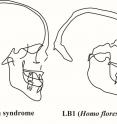New research counters claim that the 'Hobbit' had Down syndrome
Analysis of a wealth of new data contradicts an earlier claim that LB1, an ~80,000 year old fossil skeleton from the Indonesian island of Flores, had Down syndrome, and further confirms its status as a fossil human species, Homo floresiensis. From the start, fossils of a tiny population of human-like creatures from Flores (the so-called "Hobbits" of Southeast Asia) have been controversial. Are these remains evidence of a new species of fossil human, Homo floresiensis? Or are these remains simply a population of small-bodied humans (Homo sapiens), like ourselves, but with one or more individuals suffering from a developmental disorder? Researchers recently diagnosed LB1, the most complete individual recovered, with Down syndrome.
New analysis of features from across the skeleton by an international team of researchers led by Karen Baab, Ph.D., Assistant Professor of Anatomy at Midwestern University in Glendale, AZ, convincingly demonstrates that LB1 did not have Down syndrome. In addition to measuring individual bones, the scientists used CT scanning to reconstruct the brain and view internal structures of the skull, as well as assessing the 3-dimensional (3D) shape of the skull.
The study, titled "A Critical Evaluation of the Down Syndrome Diagnosis for LB1, Type Specimen of Homo floresiensis," is published in the June 8, 2016 edition of PLOS ONE.
Down Syndrome
The diagnosis of Down syndrome is the most recent in a long line of diseases attributed to this particular skeleton. Down syndrome is a chromosomal disorder characterized by cognitive delays and often certain physical features, including reduced stature and brain size. The original diagnosis also emphasized the wide and short (front-to-back) shape of the skull, shape of the chin, and short femur (thigh bone) in LB1 as evidence of Down syndrome. Diagnosing Down syndrome in fossils is complicated by the fact that many common features are found in the soft tissues of the body, which do not fossilize. Nevertheless, this study provides new information about the size and shape of the brain and skull in the Down syndrome population.
Down Syndrome Diagnosis a Bust
For the current study, the team compared physical traits preserved in the skeleton of LB1 to those found in Down syndrome. While people with Down syndrome are not identical to one another, it was nevertheless clear that LB1 was very distinct from all humans, including those with Down syndrome.
The study found that LB1's brain was much smaller than that seen in Down syndrome individuals. Likewise, the shape of the skull vault, which surrounds the brain, and chin anatomy were both outside the range seen in humans, with or without Down syndrome. Moreover, the diminutive LB1 individual, estimated to be just over a meter (1.09 m) in height (or 3' 7"), was well below the height range of comparable individuals with Down syndrome. In fact, females with Down syndrome from Turkey reach a comparable height as the adult LB1 by 6.5 years of age and are considerably taller as adults (1.45 m or 4' 9" on average). The femur is disproportionately short in LB1 relative to the feet and arms compared to all humans, regardless of whether they have Down syndrome.
LB1 Remains Type Specimen of Homo Floresiensis
Importantly, this study indicated that LB1 not only differed from individuals with Down syndrome, but was more clearly aligned with more archaic human species. Its small brain, low cranial vault shape, absence of a chin, smaller body size and limb proportions all point to a pre-Homo sapiens ancestry. The authors conclude: "The skeletal evidence overwhelmingly contradicts a diagnosis of Down syndrome. Rather, our study is yet further evidence that Homo floresiensis was a distinct species with a fascinating, if somewhat nebulous, evolutionary history."
Source: Midwestern University
Articles on the same topic
- New fossils shed light on the origin of 'hobbits'Thu, 9 Jun 2016, 14:00:43 UTC
Other sources
- [In Depth] Likely hobbit ancestors lived 600,000 years earlierfrom Science NOWThu, 9 Jun 2016, 19:41:01 UTC
- New research counters claim that the 'Hobbit' had Down syndromefrom Science DailyThu, 9 Jun 2016, 13:30:55 UTC
- How the Homo floresiensis kept their tools as they shrank into island lifefrom PhysorgThu, 9 Jun 2016, 13:21:22 UTC
- Hobbit find shows tiny humans shrank 'rapidly'from BBC News: Science & NatureThu, 9 Jun 2016, 8:51:04 UTC
- Fossils of 'Hobbit' ancestors reveal probable origin of tiny human cousinsfrom CBC: Technology & ScienceWed, 8 Jun 2016, 18:40:54 UTC
- New research counters claim that the 'Hobbit' had Down syndromefrom PhysorgWed, 8 Jun 2016, 18:21:33 UTC
- How Ancient Human-Like "Hobbits" Got So Smallfrom PopSciWed, 8 Jun 2016, 18:00:56 UTC
- Likely ancestor of mystery 'hobbit' foundfrom PhysorgWed, 8 Jun 2016, 17:51:15 UTC
- New fossils may settle debate over 'Hobbit' people's ancestryfrom Reuters:ScienceWed, 8 Jun 2016, 17:40:55 UTC
- New fossil find in Indonesia could represent the ancestors of the mysterious "Hobbit" speciesfrom LA Times - ScienceWed, 8 Jun 2016, 17:31:07 UTC
- Fossils show Hobbits shrank 'rapidly'from BBC News: Science & NatureWed, 8 Jun 2016, 17:21:23 UTC
- Photos: Hobbit Relative Discovered on Floresfrom Live ScienceWed, 8 Jun 2016, 17:21:02 UTC
- Miniature 'Hobbit' Humans Had Even Smaller Ancestorsfrom Live ScienceWed, 8 Jun 2016, 17:21:01 UTC
- New fossils push 'hobbit' story back to 700,000 years agofrom AP ScienceWed, 8 Jun 2016, 17:10:53 UTC
